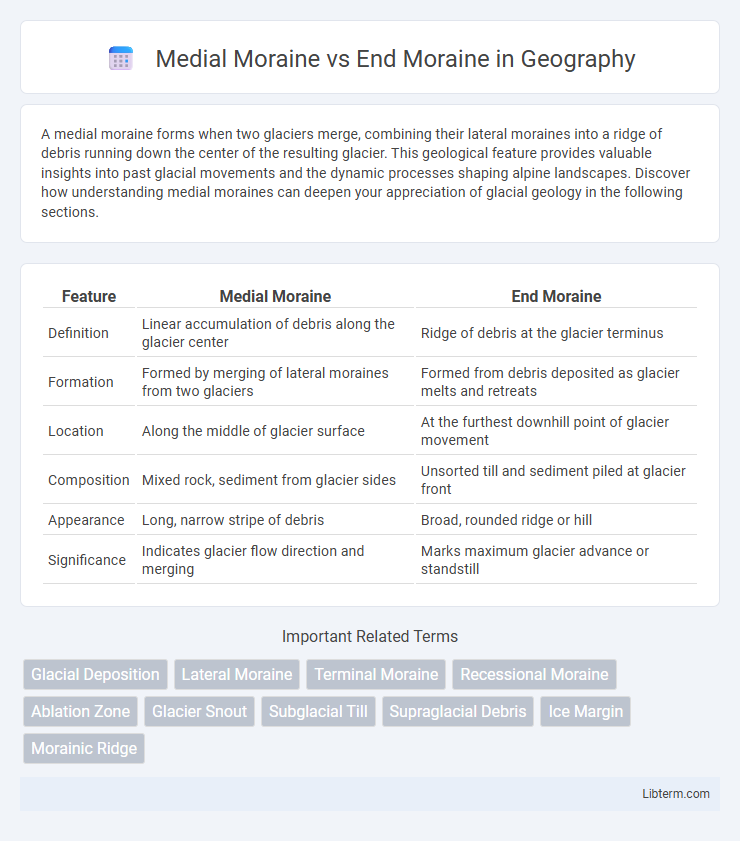A medial moraine forms when two glaciers merge, combining their lateral moraines into a ridge of debris running down the center of the resulting glacier. This geological feature provides valuable insights into past glacial movements and the dynamic processes shaping alpine landscapes. Discover how understanding medial moraines can deepen your appreciation of glacial geology in the following sections.
Table of Comparison
| Feature | Medial Moraine | End Moraine |
|---|---|---|
| Definition | Linear accumulation of debris along the glacier center | Ridge of debris at the glacier terminus |
| Formation | Formed by merging of lateral moraines from two glaciers | Formed from debris deposited as glacier melts and retreats |
| Location | Along the middle of glacier surface | At the furthest downhill point of glacier movement |
| Composition | Mixed rock, sediment from glacier sides | Unsorted till and sediment piled at glacier front |
| Appearance | Long, narrow stripe of debris | Broad, rounded ridge or hill |
| Significance | Indicates glacier flow direction and merging | Marks maximum glacier advance or standstill |
Introduction to Glacial Moraines
Glacial moraines are accumulations of debris deposited by glaciers, serving as key indicators of past glacial movement and dynamics. Medial moraines form when debris from the lateral moraines of two merging glaciers combines, creating a ridge along the center of the glacier. In contrast, end moraines accumulate at the glacier's terminus, marking the maximum advance of the glacier and often appearing as prominent ridges of till.
Defining Medial Moraines
Medial moraines are linear accumulations of debris formed when two glaciers merge, causing their lateral moraines to combine and deposit material along the center of the resulting glacier. End moraines, in contrast, are ridges of debris deposited at the glacier's terminus, marking the furthest advance of the ice. Medial moraines provide critical evidence of glacier flow patterns and the interaction between converging ice streams.
Understanding End Moraines
End moraines form as accumulations of debris at the terminus of a glacier, marking its maximum advance and serving as geological indicators of past glacial activity. Unlike medial moraines, which develop from the merging of lateral moraines between two glaciers, end moraines consist primarily of unsorted till deposited when glacial ice melts. These ridges help scientists reconstruct glacial extents and climate changes by analyzing their composition and spatial distribution.
Formation Processes of Medial Moraines
Medial moraines form when two valley glaciers converge, causing their lateral moraines to merge and create a ridge of debris running down the center of the combined glacier. This process involves the accumulation of rock, soil, and sediment from the inner edges of the adjacent glaciers, which are transported and deposited along the glacier's length as it moves. Unlike end moraines, which form at glacier termini from deposited material during glacier retreat, medial moraines result specifically from the merging of debris carried internally between glacier flows.
Formation Mechanisms of End Moraines
End moraines form through the accumulation of debris deposited at the snout or terminus of a glacier, marking its maximum advance and retreat stages. These ridges of till result from the glacier's advancing ice pushing and bulldozing sediment forward, followed by melting processes that leave behind unsorted glacial debris. In contrast, medial moraines develop from the merging of lateral moraines when two glaciers converge, creating a linear accumulation of debris along the glacier's centerline.
Key Differences: Medial Moraine vs End Moraine
Medial moraine forms along the central line of a glacier where two glaciers merge, composed mainly of debris from the adjacent valley walls, whereas end moraine accumulates at the glacier's terminus, marking its furthest advance. Medial moraines appear as dark stripes running parallel to the ice flow, contrasting with the transverse ridges of end moraines that indicate past glacier margins. The composition of medial moraines largely consists of rock fragments transported within the glacier, while end moraines comprise a mix of unsorted till deposited at the glacier snout.
Geological Significance of Moraines
Medial moraines form from the merging of lateral moraines when two glaciers converge, creating a ridge of debris parallel to the glacier flow that reveals the dynamics of glacier interaction and past ice movement. End moraines accumulate at the terminus of a glacier, marking the furthest advance of the ice and serving as critical indicators for reconstructing glacial extents and climatic conditions during glacial maxima. Both medial and end moraines provide valuable geological records that help scientists understand past climate changes, glacier behavior, and sediment transport processes in glaciated landscapes.
Examples of Medial and End Moraines Worldwide
Medial moraines, formed where two glaciers merge, are prominently visible in Alaska's Matanuska Glacier and the Swiss Alps' Aletsch Glacier, showcasing dark, linear debris stripes along ice surfaces. End moraines, marking the furthest extent of glacial advance, are well exemplified by the extensive Terminal Moraine in Long Island, New York, and the prominent Moraines of the Great Lakes region, such as the Port Huron moraine system. These examples highlight distinct glacial depositional features critical for understanding past ice flow patterns and climatic conditions globally.
Ecological Impact of Moraines
Medial moraines and end moraines significantly influence ecological succession by shaping soil composition and moisture retention patterns in glacial landscapes. Medial moraines, formed from debris carried between two glaciers, tend to create narrow, elevated ridges that promote unique microhabitats supporting specialized vegetation and wildlife. End moraines, deposited at glacier termini, form extensive ridges that modify drainage systems and create diverse wetland ecosystems critical for biodiversity and nutrient cycling.
Conclusion: Importance in Glacial Geomorphology
Medial moraines and end moraines serve as critical indicators in glacial geomorphology, revealing the dynamics and extents of glacier movement. Medial moraines, formed by the merging of lateral moraines from converging glaciers, highlight the internal ice flow and sediment transport within glacier systems. End moraines mark the maximum advance of glaciers, providing valuable evidence for reconstructing past glacier extents and climate variations.
Medial Moraine Infographic

 libterm.com
libterm.com